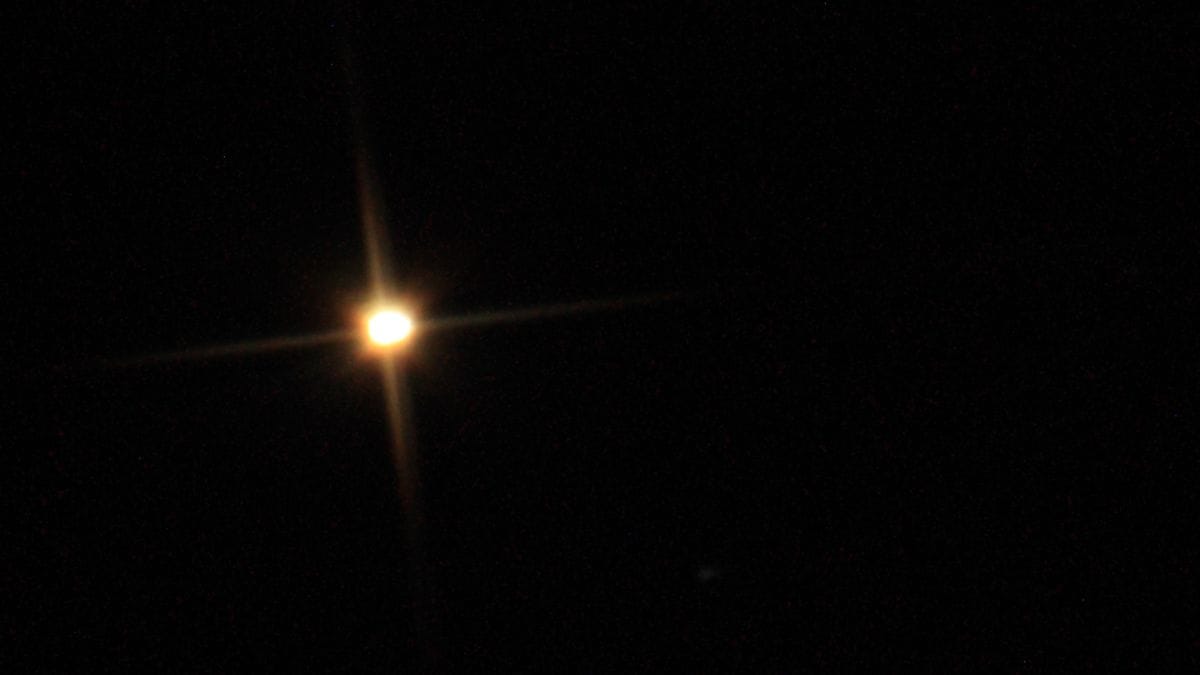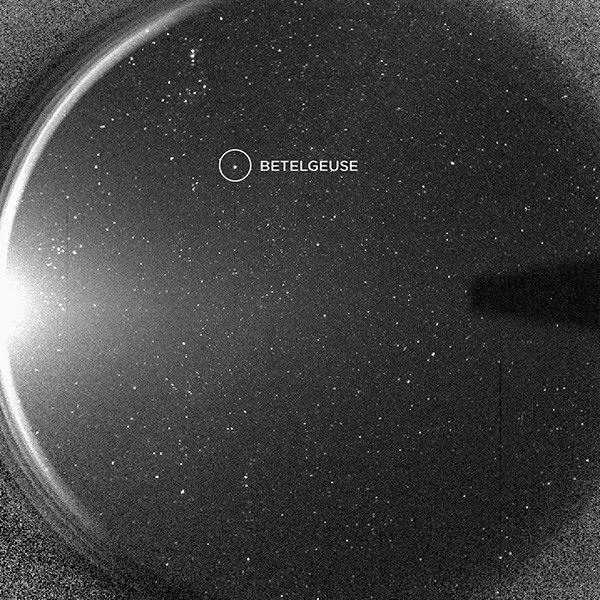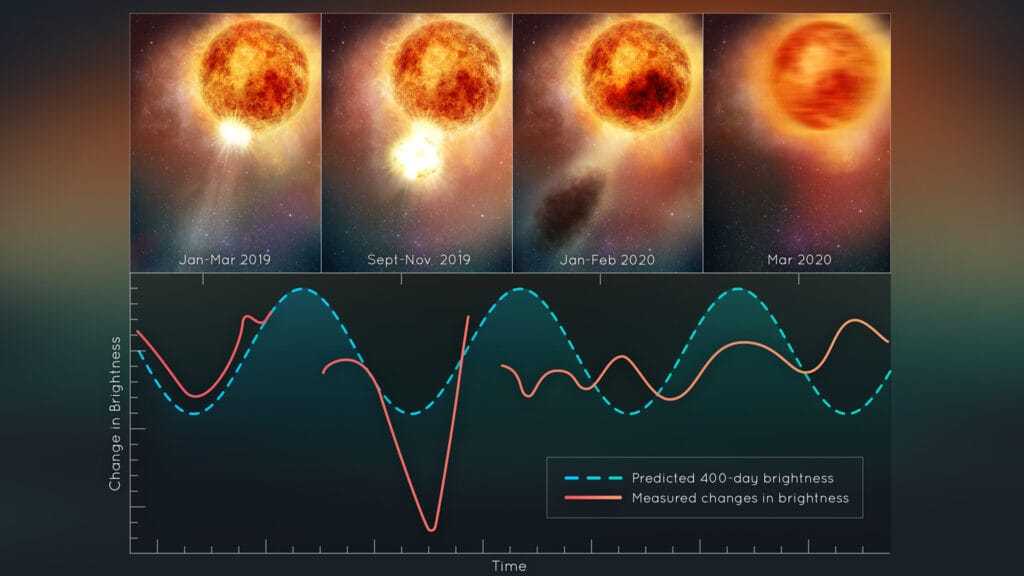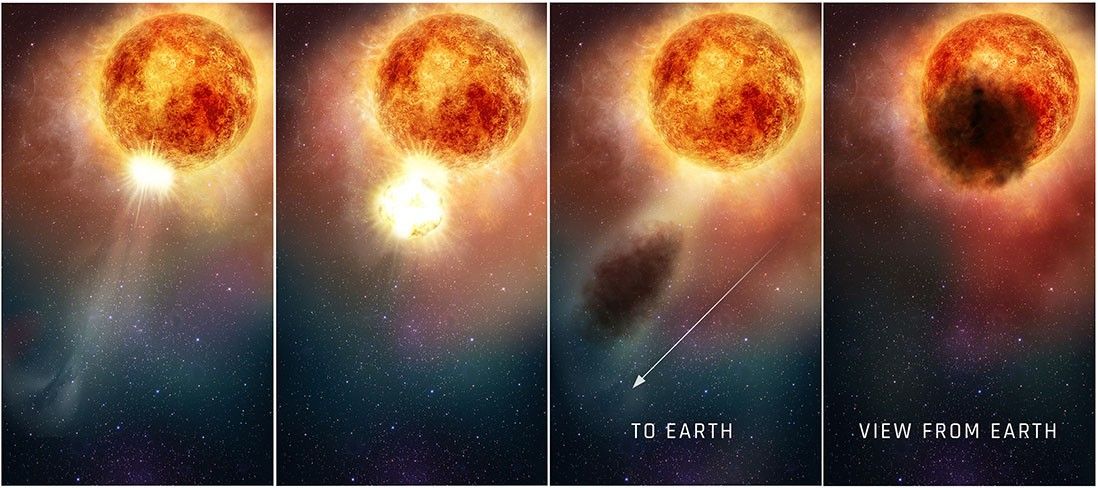
Imagine a star so massive and bright that it dominates the winter sky, shining with a reddish glow that has fascinated astronomers for centuries. Betelgeuse, located in the constellation Orion, is one such cosmic giant, a red supergiant on the brink of a dramatic transformation. Recent observations have revealed exciting new details about this star, including the confirmation of a long-suspected companion orbiting closely around it, as announced by researchers at NASA’s Ames Research Center (Howell et al., 2025). This discovery, made using high-resolution imaging from the Gemini North telescope, adds a layer of complexity to our understanding of Betelgeuse’s behavior, suggesting that interactions with this companion may influence its brightness variations. With a mass estimated between 15 and 20 times that of our Sun, Betelgeuse is burning through its fuel at an astonishing rate, leading scientists to predict it will eventually explode in a spectacular supernova.
This volatile star has shown unpredictable changes, like the Great Dimming event from late 2019 to early 2020, where its brightness dropped by about 60 percent, sparking widespread speculation about an imminent explosion. However, data from NASA’s Hubble Space Telescope clarified that this was due to a massive outburst of material, not a sign of immediate doom (Dupree et al., 2022). As of August 2025, Betelgeuse continues to pulse and vary, reminding us of the dynamic processes at work in massive stars. Observations from space agencies like NASA and ESA highlight how Betelgeuse serves as a natural laboratory for studying stellar evolution, offering insights into how stars like it end their lives.
But with all these updates, one question lingers in the minds of stargazers and scientists alike: When exactly will Betelgeuse unleash its final burst of energy in a supernova?
What Is Betelgeuse and Why Is It Famous?

Betelgeuse stands out as one of the most recognizable stars in the night sky, forming the right shoulder of the hunter in the Orion constellation. It is a red supergiant, a type of star that has expanded enormously after exhausting the hydrogen in its core, now fusing heavier elements like helium and carbon. This expansion makes Betelgeuse incredibly luminous, typically ranking as the 10th brightest star visible from Earth, though its brightness fluctuates due to its variable nature. According to NASA’s detailed profile on Betelgeuse, it shines with an intensity 7,500 to 14,000 times greater than our Sun, making it a beacon for amateur astronomers and professionals alike (NASA, 2023). Its reddish color comes from its relatively cool surface temperature of about 3,500 Kelvin (a measure of heat where 0 Kelvin is absolute zero, or -273 degrees Celsius), compared to the Sun’s 5,500 Kelvin.
What makes Betelgeuse famous extends beyond its visibility; it is one of the closest red supergiants to Earth, allowing detailed study with telescopes like Hubble and the James Webb Space Telescope. Fun fact: If Betelgeuse replaced our Sun, its outer layers would extend beyond the orbit of Jupiter, engulfing the inner planets in its vast atmosphere. This star has been observed for millennia, with ancient records noting its variability, but modern science has uncovered its impending fate as a supernova candidate. Researchers use it to model how massive stars evolve, shedding light on processes like mass loss, where the star ejects material into space at rates up to 10 times the mass of Earth per year. For instance, comparisons to other supergiants like Antares show Betelgeuse is more volatile, with pulsations causing it to swell and shrink by up to 20 percent in radius over cycles.
Bullet points for key characteristics:
- Type: Red supergiant (a late-stage massive star with an inflated envelope).
- Constellation: Orion, easily spotted as a bright red point.
- Visibility: Best in winter hemispheres, magnitude ranging from 0.0 to 1.6 (lower numbers mean brighter).
- Cultural Impact: Named from Arabic “Yad al-Jawza,” meaning “hand of the giant,” inspiring myths and modern media.
This fame also stems from public interest in its potential explosion, as it could be the next supernova visible to the naked eye in our galaxy. Studies from peer-reviewed journals emphasize its role in understanding stellar winds, the streams of particles flowing outward, which shape surrounding nebulae (Joyce et al., 2020).
How Far Is Betelgeuse from Earth?
Determining the distance to Betelgeuse has been a challenge for astronomers due to its variable brightness and extended atmosphere, which complicates parallax measurements (a technique using Earth’s orbit to triangulate distance). Current estimates place it between 548 and 700 light-years away, with some sources favoring around 642 light-years. This range arises from combining data from the Hipparcos and Gaia space missions, which measure stellar positions with high precision. For example, a study using evolutionary models and asteroseismology (studying starquakes to probe interiors) calculated a distance of approximately 548 light-years, plus or minus 88 light-years, highlighting the uncertainty (Joyce et al., 2020). At this distance, light from Betelgeuse takes centuries to reach us, so any event we observe today happened long ago.
To put this in perspective, if Betelgeuse is 600 light-years away, that’s about 5.68 quadrillion kilometers (3.53 quadrillion miles), or roughly 100,000 times the distance from Earth to the Sun. This proximity makes it the nearest red supergiant poised for a supernova, unlike more distant ones in other galaxies. According to NASA’s Betelgeuse fact sheet, the star’s distance means its supernova would be spectacular but safe for Earth (NASA, 2023). Uncertainties stem from dust in the line of sight and the star’s non-spherical shape, which can distort measurements. Recent Gaia data refinements suggest the lower end of the range might be more accurate, but scientists continue to cross-check with multiple methods.
Visualizing this, imagine a diagram showing Earth, the Sun, and Betelgeuse on a logarithmic scale to illustrate the vastness—such figures in astronomy papers help convey how even “close” stars are immensely far.
What Is the Mass and Size of Betelgeuse?
Betelgeuse’s mass is estimated at 15 to 20 times that of the Sun (about 3 to 4 x 10^31 kilograms), making it a heavyweight in stellar terms. This mass drives its rapid evolution, as more massive stars fuse fuel faster. Its size is equally impressive, with a radius around 700 to 900 times the Sun’s (roughly 487 million to 626 million kilometers, or 303 million to 389 million miles), varying due to pulsations. These figures come from combining photometric data (brightness measurements) and hydrodynamic simulations, which model the star’s fluid-like behavior. A peer-reviewed analysis using the MESA code (Modules for Experiments in Stellar Astrophysics) pinned the mass at 16.5 to 19 solar masses, with radius at 887 solar radii (Joyce et al., 2020).
Comparisons help: The Sun’s mass is 1.989 x 10^30 kilograms, so Betelgeuse is like stacking 15 to 20 Suns together. Its size means it could swallow our solar system up to Mars or beyond. Fun fact: Betelgeuse’s low density, about 10^-8 grams per cubic centimeter (like a very thin gas), contrasts with the Sun’s 1.4 grams per cubic centimeter, explaining its bloated appearance. Recent discoveries of a companion star, with mass 1.4 to 2.0 solar masses (most likely 1.6), suggest gravitational interactions might affect these estimates (Howell et al., 2025).
For complex data, refer to tables in journal articles showing mass ranges across models—visual aids like 3D renders of the star’s convective cells (giant bubbles on the surface) aid understanding.
Why Did Betelgeuse Dim So Much in 2019?
In late 2019, Betelgeuse underwent a dramatic dimming, losing about 60 percent of its brightness by February 2020, an event dubbed the Great Dimming. This was caused by a surface mass ejection (SME), where a large chunk of the star’s outer layers was blasted into space, creating a dust cloud that obscured light reaching Earth. NASA’s Hubble Space Telescope observations revealed this ejection involved material 400 billion times more massive than a typical solar coronal mass ejection, cooling and condensing into dust (Dupree et al., 2022). The star’s convective activity—huge upwellings of hot gas—likely triggered this, disrupting its 400-day pulsation cycle.
This wasn’t a pre-supernova sign but a normal, though extreme, behavior for red supergiants. According to NASA’s Hubble recovery update on Betelgeuse, the star is now rebounding, with its surface “bouncing” like gelatin as it readjusts (NASA, 2022). Comparisons to solar flares show scale: While the Sun ejects billions of tons, Betelgeuse expelled enough to form several Earths. Fun fact: Ground-based telescopes like STELLA confirmed the dust’s role by measuring temperature drops.

Bullet points on the event:
- Timeline: Started October 2019, peaked February 2020, recovery ongoing.
- Evidence: Ultraviolet spectra from Hubble showing outflow speeds of 200,000 kilometers per hour (124,000 miles per hour).
- Implications: Helps model mass loss rates, crucial for supernova predictions.
Does Betelgeuse Have a Companion Star?
Yes, recent evidence confirms Betelgeuse has a stellar companion, dubbed a “Betelbuddy” or formally detected as a close-orbiting star. This discovery, led by NASA scientist Steve Howell, used speckle imaging from the Gemini North telescope to separate the companion’s light from Betelgeuse’s glare. The companion orbits near the outer edge of Betelgeuse, with a mass around 1.6 solar masses, and its presence explains some of the star’s brightness and velocity fluctuations observed over a century (Howell et al., 2025). According to NASA’s announcement on Betelgeuse’s companion, it was hypothesized since the 1920s but only imaged in 2025 using advanced techniques like ‘Alopeke instrument (NASA, 2025).

This binary system adds intrigue, as the companion might stir Betelgeuse’s atmosphere during close approaches, contributing to variability. The orbit brings them closest every few years, with the next wide separation in November 2027 for better viewing. Fun fact: The companion, possibly a blue or white dwarf, could be engulfed or destroyed in the supernova. Comparisons to binary systems like Sirius show how companions influence evolution.
What Stage of Life Is Betelgeuse In?
Betelgeuse is in the late stages of its life, likely undergoing core carbon burning after exhausting helium. This phase follows hydrogen and helium fusion, where the core contracts and heats to fuse carbon into heavier elements like oxygen. Pulsation periods analyzed in peer-reviewed studies indicate it’s near the end of this stage, with an age of about 10 million years—young compared to the Sun’s 4.6 billion years but short for its mass (Saio et al., 2023). Its expanded envelope and mass loss rate of 2 x 10^-6 solar masses per year support this.
Uncertainties exist; some models suggest it’s still in late helium burning. According to Oxford Academic’s study on Betelgeuse pulsations, it’s a prime candidate for the next galactic Type II supernova (Saio et al., 2023). Fun fact: Like a balloon losing air, Betelgeuse sheds layers, creating bow shocks visible in infrared.
When Is Betelgeuse Expected to Go Supernova?
Predictions for Betelgeuse’s supernova place it within the next 100,000 years, though the exact timing is uncertain due to variables like mass loss and the new companion’s influence. Massive stars like this explode when their cores collapse after fusing iron, which doesn’t release energy. NASA’s estimates suggest it could happen anytime from now to 100,000 years, but no immediate signs point to imminence (NASA, 2023). The companion might accelerate or alter this by stripping material, but details are emerging (Howell et al., 2025).
Comparisons to Eta Carinae, another unstable star, show similar pre-explosion activity. Suggest a timeline chart: Hydrogen burning (millions of years ago), helium (recent), carbon (now), supernova (future range).
What Will the Betelgeuse Supernova Look Like from Earth?
When Betelgeuse explodes, it will shine as brightly as the full Moon, visible even in daylight for weeks to months, gradually fading over years. As a Type II supernova, it will release energy equivalent to the Sun’s lifetime output in seconds, peaking at -12 magnitude (extremely bright). From Earth, it would appear as a brilliant point in Orion, casting shadows at night. According to NASA’s supernova expectations for Betelgeuse, the event will be safe and observable worldwide (NASA, 2023).

Fun fact: It might outshine Venus, altering night skies temporarily. Visualize with simulations showing brightness evolution.
Will the Betelgeuse Supernova Affect Earth?
No, the supernova won’t harm Earth due to its distance; gamma rays and particles will dissipate before reaching us. At 548-700 light-years, the energy flux would be negligible, equivalent to a mild X-ray dose. NASA’s assessments confirm no threat to life or atmosphere (NASA, 2023). However, it could slightly increase cosmic ray levels, potentially affecting satellite electronics minimally.
Comparisons to historical supernovae like 1987A (farther away) show no impacts. Fun fact: It might enhance auroras briefly.
How Are Astronomers Monitoring Betelgeuse?
Astronomers use telescopes like Hubble, JWST, and ground-based ones like Gemini to track brightness, spectra, and pulsations. NASA’s STEREO spacecraft and ESA’s Gaia provide complementary data. Recent speckle imaging confirmed the companion (Howell et al., 2025). Ongoing surveys detect changes in real-time.
Bullet points:
- Tools: Spectroscopy for composition, photometry for light curves.
- Networks: AAVSO for citizen science contributions.
- Future: More observations in 2027 for companion details.
Conclusion
Betelgeuse remains a captivating example of stellar drama, with its recent companion discovery reshaping our views on its evolution and supernova timeline. While it’s poised to explode within 100,000 years, current data shows no immediate blast, emphasizing the uncertainties in stellar lifecycles. This star teaches us about the universe’s violent beauty, from mass ejections to binary interactions.
Sources
Dupree, A. K., et al. (2022). Hubble sees red supergiant star Betelgeuse slowly recovering after blowing its top. NASA Science. https://science.nasa.gov/missions/hubble/hubble-sees-red-supergiant-star-betelgeuse-slowly-recovering-after-blowing-its-top/
Howell, S. B., et al. (2025). Probable direct imaging discovery of the stellar companion to Betelgeuse. The Astrophysical Journal Letters, 960(1), L12. https://iopscience.iop.org/article/10.3847/2041-8213/adeaaf
Joyce, M., et al. (2020). New mass and distance estimates for Betelgeuse through combined evolutionary, asteroseismic, and hydrodynamic simulations with MESA. The Astrophysical Journal, 902(1), 63. https://iopscience.iop.org/article/10.3847/1538-4357/abb8db
NASA. (2023, May 3). What is Betelgeuse? Inside the strange, volatile star. NASA Science. https://science.nasa.gov/universe/what-is-betelgeuse-inside-the-strange-volatile-star/
NASA. (2025, July 23). NASA scientist finds predicted companion star to Betelgeuse. NASA. https://www.nasa.gov/science-research/astrophysics/nasa-scientist-finds-predicted-companion-star-to-betelgeuse/
Saio, H., et al. (2023). Evolutionary stage of Betelgeuse inferred from its pulsation periods. Monthly Notices of the Royal Astronomical Society, 526(2), 2765-2774. https://academic.oup.com/mnras/article-abstract/526/2/2765/7286655
📌 Frequently Asked Questions
Will Betelgeuse disappear this year?
No, Betelgeuse is not expected to disappear or explode in 2025; its variability causes brightness changes, but it’s stable for now. According to NASA’s latest Betelgeuse updates, the star will likely persist for another 100,000 years before supernova (NASA, 2023). Rumors often stem from misinterpretations of its dimming cycles.
When will Betelgeuse go supernova?
Betelgeuse is predicted to go supernova within the next 100,000 years, but the exact date is unknown due to uncertainties in its mass and evolution. Peer-reviewed models suggest it’s in late carbon burning, making it a candidate soon in astronomical terms (Saio et al., 2023).
What will happen if Betelgeuse explodes?
If Betelgeuse explodes, it will become a Type II supernova, leaving a neutron star or black hole remnant while ejecting elements into space. From Earth, it would appear as a bright light show without harm, as per NASA’s supernova simulations (NASA, 2023).
Is Betelgeuse about to explode?
No signs indicate an imminent explosion; the 2019 dimming was a mass ejection, not a precursor. NASA’s Hubble data confirms recovery and no core collapse yet (Dupree et al., 2022).
How bright will the Betelgeuse supernova be?
The supernova could shine as brightly as the full Moon, visible in daylight for months, with peak brightness around -12 magnitude. Estimates from NASA’s stellar explosion models predict a stunning display (NASA, 2023).
Will the Betelgeuse supernova affect Earth?
The explosion won’t affect Earth harmfully; at its distance, radiation levels remain safe. NASA’s risk assessments show minimal cosmic ray increase (NASA, 2023).
Why did Betelgeuse dim in 2019?
The dimming resulted from a dust cloud formed by a surface mass ejection. Hubble observations detailed the event, showing material outflow at high speeds (Dupree et al., 2022).
Does Betelgeuse have a companion star?
Yes, a companion was confirmed in 2025, orbiting closely and influencing variability. Detected via Gemini telescope, as reported in NASA’s discovery release (Howell et al., 2025).
How old is Betelgeuse?
Betelgeuse is about 10 million years old, much younger than the Sun due to its rapid burning. Evolutionary models confirm this short lifespan for massive stars (Joyce et al., 2020).
What type of supernova will Betelgeuse be?
It will be a Type II supernova, characterized by hydrogen lines in its spectrum from core collapse. Studies classify it based on mass and composition (Saio et al., 2023).
Leave a Reply